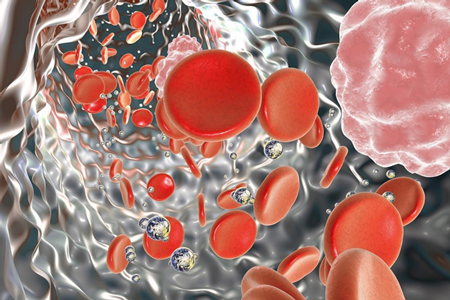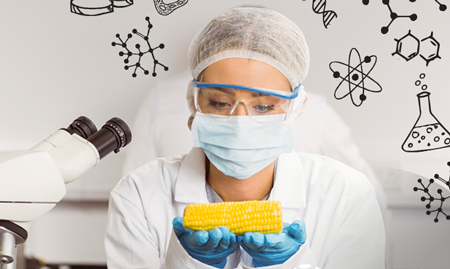Nanotechnology: How Do We Protect Ourselves?
Problem with Nanotechnology in a Nutshell
It is extremely easy to get nanotechnology into our bodies, but the human body has difficulty removing it and preventing it from accumulating.

Our immune systems have been weakened by the constant bombardment with chemicals such as glyphosate, which contaminates nearly all of our food including organic products. These chemicals strip out essential minerals from our bodies and damage the normal bacteria in our guts.
The normal human microbiome in the gut is the primary home for our immune system. When we add the stress caused by the constant exposure to a thousand different radio and microwave frequencies, our bodies are further weakened so that they cannot effectively respond to penetration by nano substances. As a result, nanotechnology which has been programmed to perform certain tasks can operate in us with relative freedom.
Even if nanotechnology is intended for good, such as when it is added to a medicine, supplement, skincare product, processed food, or when sprayed on the crops raised by farmers it is still very difficult to remove from the body.
Nanotechnology can also be intended for harm as when it is sprayed in the atmosphere above the Earth. In this case, it is designed to secretly create physical lethargy, to inhibit mental clarity, to provide a mechanism for establishing mind control programming, to modify human DNA, and to stimulate disease formation and early death.
Regardless of the intent behind nanotechnology, it is embedding itself in our bodies on a daily basis and is establishing networks within us that have the quality of a pseudo-lifeform or synthetic biology. It is not just inert small pieces of junk that just sit there, but it fulfills its mission to self-assemble into structures that perform functions according to those who programmed the materials.
The problem is that once nanotechnology enters our bodies, our brains, our cells, and even modifies our DNA, then extraordinary steps must be taken to deprogram it and remove it. Thus, even nanotechnology intended for good eventually becomes part of a toxic condition in our bodies, and becomes something that we need to help our bodies remove.
The Precautionary Principle is being Ignored by Government and Industry
The US government and the industries that are developing and selling nanotechnology products do not embrace the precautionary principle. Instead of proving that nano is safe before manufacturing it for product distribution, they are doing the opposite — manufacture and sell first and then study later – much later.
National Nanotechnology Initiative
The National Nanotechnology Initiative (NNI) has assembled leading nanotechnology leaders from 25 US government agencies to coordinate the government’s response to the development of nanotechnology by government and industry. In 2011 the Environmental, Health, and Safety Research Strategy was published by the NNI, which was intended to guide the safe development of nanotechnology. They didn’t do safety studies — they just developed definitions for nanotechnology and formulated risk assessment policy guidelines.
The NNI is of course concerned about nano safety, because it is one of their priorities to assure the public that we should not be concerned about nanotechnology. They are trusting in their definitions and guidelines to keep us all safe. Despite the NNI mandate about public health and safety, their focus falls squarely on supporting research and development of new products.
Are Government Agencies Convinced that Nanotechnology is Safe?
This is what US government regulators say: “The National Institute of Occupational Health (NIOSH) as would be expected, is focusing their concerns on the safety of workers who handle nano materials. This is what they understand about nano: “Occupational health risks associated with manufacturing and using nanomaterials are not yet clearly understood. Minimal information is currently available on dominant exposure routes, potential exposure levels, and material toxicity of nanomaterials. Studies suggest that some nanoparticles can move from the respiratory system to other organs. Research is continuing to understand how these unique properties may lead to specific health effects.”
In other words they don’t understand the risks, but are allowing workers to handle the materials anyway.

The National Organic Program (NOP), which oversees organic certification programs, makes these statements in their Nano Fact Sheet: “The NOP does not consider nanotechnology to be intrinsically benign or harmful. As with other substances, no engineered nanomaterial will be allowed for use in organic production and handling unless the substance has been: 1) petitioned for use; 2) reviewed and recommended by the NOSB; and 3) added to the National List through notice and comment rulemaking.”
In other words, they are sitting on the fence and will consider requests from industry when they are made. They are not going to draw a line in the sand and just say “not in organic food.”
The National Institute of Environmental Health Sciences (NIEHS) states: “Due to their tiny size, engineered nanomaterials (ENM) have unique properties that have the potential to advance electronics, medicines, and other fields. However, while ENM have many promising benefits, we know very little about their potential effects on human health and the environment. Recognizing that engineered nanomaterials (ENM) are increasingly being used in everyday products, such as pharmaceuticals, cosmetics, sunscreens, clothing, and electronics, NIEHS has developed an interagency federal research strategy to explore this emerging field. The outcome of these efforts will allow scientists to design nanomaterials that are both innovative and safe for commercialization.”
In other words, they know nanotechnology is already being used in most sectors of the manufacturing economy, and they are starting to develop a plan to study health and safety issues.
The US Geological Survey has been studying snails and other aquatic life. They stated: “USGS scientists are studying the linkages between contaminant bioavailability and toxicity, especially in aquatic organisms exposed to metals and metallo-nanomaterials through solution and diet. The intent is to improve understanding of the physiological and geochemical processes influencing bioaccumulation and toxicity. ZnO nanoparticles damage digestion, although it was not clear whether the toxicity was due to the high Zn dose achieved with nanoparticles or to the ZnO nanoparticles themselves. Further study of exposure from nanoparticles in food would greatly benefit assessment of ecological and human health risks.”
In other words, it looks like some nanomaterials are a problem for snails, therefore there is reason for concern about human health. The government is studying snails, but not long term effects on humans.
The US Food and Drug Administration (USFDA) has policies about products that use nanoscale materials. The FDA states: “Since this report published [in 2007 by the Nanotechnology Taskforce] FDA issued several guidance documents on topics relating to application of nanotechnology in FDA-regulated products. While guidance documents do not create or confer any rights for or on any person and do not operate to bind FDA or the public, they do represent FDA’s current thinking on a topic. Industry remains responsible for ensuring that its products meet all applicable legal requirements, including standards for safety — regardless of the emerging nature of a technology involved in the manufacturing of a product.”
In other words, regardless of what the FDA thinks about nanotechnology, it is up to private industry to assess human safety for the nano products they produce or use. It’s not the FDA’s problem or concern.
Given the failure of the pharmaceutical industry to protect the public from vaccine harm and the failure of telecom companies to protect us from microwave radiation harm, do we have the slightest reason to believe that the manufacturers of nanotechnology will protect us from being harmed by nano?
To be fair to the US government, it has funded almost 500 studies about nanotechnology since 2010, but we haven’t seen any restrictions applied to the marketing, sales, or use of nanotechnology because of the research, even though some studies show risks to animal health.
Safety of the Chemtrails Geoengineering Spraying Program

Beyond the industrial, agricultural, cosmetic, processed food, and medical uses for nanotechnology that US government agencies say they are studying, we must wonder about the unknown quantity of nano substances that the US government is spraying over the entire country on a daily basis through its aerial spraying programs (chemtrails), also known as geoengineering. These spraying programs operate without public oversight. As far as anyone knows, the harmful health effects have not been studied for the sake of preventing harm though secret studies that may have been conducted by the US government to determine levels of intentional harm.
We don’t know the entire list of substances (nano and larger) that are being sprayed into the atmosphere. This is some of what is falling on us and on farm fields every day after chemtrail spraying: “Over the past decade, independent testing of chemtrails around the country has shown a dangerous, extremely poisonous brew that includes: barium, nano aluminum-coated fiberglass [known as CHAFF], radioactive thorium, cadmium, chromium, nickel, desiccated blood, mold spores, yellow fungal mycotoxins, ethylene dibromide, and polymer fibers. Barium can be compared to the toxicity of arsenic. Barium is known to adversely affect the heart. Aluminum has a history of damaging brain function. Independent researchers and labs continue to show off-the-scale levels of these poisons. A few anonymous officials have acknowledged this on-going aerosol spraying.”
A research paper from Dr. Ilya Sandra Perlingieri entitled Chemtrails – the Consequences of Toxic Metals and Chemical Aerosols on Human Health, and author of the book, The Uterine Crisis, comments on the problem we are facing today.
The late Dr. Perlingieri died under mysterious circumstances in 2013 shortly after publishing this information. She stated:
“… there are three main routes that nanoparticles can enter the human body: inhalation into the pulmonary system; absorption through the dermal system; ingestion through the gastrointestinal system. It must be highlighted that inhalation exposure is of the greatest concern with regard to the effects of particulate nanomaterials on occupational health, and special attention is being given to studying impacts on the respiratory system and the cardiovascular system.
Dermal exposure is also of importance. However, healthy skin has a better barrier function when compared to the respiratory tract although this barrier function could be limited by skin lesions, strong mechanical strain or small nanoparticles (<5 to 10 nm).
Due to the size effects, smaller particles may diffuse faster in air than their larger counterparts and can get further down the respiratory tract. In addition, it is hard to remove nanoparticles from the body as they are known to cross mucus membranes.
Potential health effects include: inflammation of airway (bronchitis, asthma, emphysema); lung cancer; neurodegenerative diseases (Parkinson’s and Alzheimer’s disease); cardiovascular effects and heart disease; liver cancer; Crohn’s disease and colon cancer.”
A Handful of Researchers Continue to Ring the Early Warning Bell about Nanotechnology
These researchers are not in government agencies, in corporation research labs, or in university research centers. They are conducting research from their personal labs. They are rigorously working to reveal the truth about nanotechnology and to develop methods that people can use to protect themselves. These researchers are raising very serious concerns based on empirical observation and review of relevant scientific literature concerning the qualities of nanotechnology and its manufacturing processes.
These researchers have witnessed extensive harm in the lives of men and women — not in theory, but based on personal observations of people who have suffered the harmful effects of nano poisoning.
According to independent researcher Jean Bryan Pelletier, when levels of nanotechnology become too high in a person’s body, they develop a wide range of symptoms of illness and can be considered as having been poisoned by toxic substances. “Nano substances are very small, but when the levels accumulate they can eventually reach a toxic threshold where a person can be said to be experiencing nano poisoning.”
One of these researchers – Tony Pantalleresco, an herbalist from Canada, was recently interviewed and specifically asked to share what he and his colleagues have documented about the human health effects of nanotechnology and high frequency microwave radiation. The interview focused on steps we can take to protect ourselves from these technologies.
Mr. Pantalleresco is part of a small group of researchers who are risking their lives by revealing the dark side of these technologies that are being used by industry and secret government programs. Both Tony Pantalleresco and Jean Bryan Pelletier (AKA Bryan396) have been targeted for harm through the application of these technologies and have been called upon to help other targeted individuals. They understand the risks of the technology and the dangers posed by those who are developing the dark side of the technology.
Removing Nanotechnology from the Body

Many of us might want to rush out and take immediate steps to clean the nano junk out of our bodies, but there can be risks unless the process is handled properly and systematically. The initial recommendations can be done by anyone at any time. Anyone who is concerned should start with these three steps.
1. Reduce your new exposure to nanotechnology by making changes in the food that is eaten, the kind of water that is drunk, the types of cosmetics and skincare products that are used, and the pharmaceuticals and supplements that are taken.
2. Build up your body’s natural defenses and detoxification pathways by taking a few select mineral supplements.
3. Protect yourself by reducing exposure to WiFi and other frequency sources, which activate nanotechnology in the body and weaken the immune system. The last part of the process must be done before any attempt is made to detoxify the existing load of nanotechnology.
4. Deprogram the existing nanotechnology that is in the body. If deprogramming is not done before detoxification, then the nanotechnology will not come out and can actually become more strongly embedded.
Limiting New Exposure to Nanotechnology
This section focuses on how to limit new exposure to nano substances in food, water, skincare products, pharmaceuticals, and supplements. These recommendations will be unpopular and some may even call them ridiculous until we stop and think about all the nano materials that are currently used in agriculture and the millions of tons of nano materials that have been falling over agricultural fields and even our home gardens for decades.
Key fact: It is impossible to escape from exposure to nano materials, but we can limit our exposure by the choices we make.
General guideline regarding products with labels: Don’t consume any food or use any skincare product, pharmaceutical, or supplement that indicates that it contains nano ingredients such as nano titanium dioxide, nano silica, (diatomaceous earth), or other nano ingredients.
The long-term health risks are likely much greater than any short-term benefit. Remember nano is easy to put into the body, but very difficult to get out.
Specific Guidelines Concerning Food
Our largest source of nano exposure, beyond what we inhale from the air, comes from the food we eat and the water we drink. As a result, a person who is concerned about minimizing consumption of nano materials may need to make new choices regarding food and water.
Tony Pantalleresco begins with a blanket warning about grains. He indicated that grains can contain nano. Thus, he advises to not eat grains because there is no way to remove the nano. This includes pseudo-grains such as quinoa, millet, buckwheat, spelt, barley, oats, rice, etc. Of course, grains are not the problem. The problem is where they have been grown and what has fallen upon them or what has been sprayed on them.
Grains grown in the United States and Canada will be contaminated with nano and glyphosate even if they are organic. Grains grown in remote areas far from the United States using organic growing methods can test free of glyphosate and may not contain the high levels of nano found in the United States where there is constant chemtrail spraying.
Tony Pantalleresco stated: “Only eat root-based vegetables. Do not eat vegetables grown above ground – they are saturated to the core with nano.”
Tony Pantalleresco explained that nano substances pass into the cells of plants and cannot be washed off. Thus, leafy greens simply must be avoided unless they are grown indoors. Even root vegetables must be peeled thickly before cooking.
Tony Pantalleresco continued: “There are very few fruits you can eat. Citrus is one of the few that doesn’t have high levels of nano saturation. All berries are shot. There isn’t one type that is fit to consume.”
“Besides, they already are working on bringing in this thing called CRISPR which is where they are manufacturing meat out of a lab. It will be completely suicidal to eat that. It will be just as bad as eating vegetables today that are grown in the field because of genetic contamination. CRISPR is already being utilized in the food supply. It is not registered or labelled as a GE or GMO even though it is.
There are no restrictions on it or regulation on it. They don’t even have to tell you it is there. It is already affecting many people by turning off their genetic code. With the activation of this with frequencies with these towers and cell phones and what-not it will activate whatever programming that has been put into that food. And people are becoming more and more compromised.”
Specific Guidelines Concerning Water
Tony Pantalleresco was asked what the safest form of water to drink is. He replied:
“The only two waters I tell people to drink are distilled or reverse osmosis. I don’t care about the minerals or anything else – I am looking at purity of water. These are the only two options that will reduce nano by 95%, the rest don’t. Unless you have a filtering system that is on a nano or pekoe level you won’t pull out everything. The only thing better than distilled and reverse osmosis is double distilled.”
Tony Pantalleresco then answered a question regarding whether the water from drilled wells was contaminated with nano: “The research I have done on those types of water systems showed that they will be loaded with bacteria and fungi, which cannot be filtered out with regular filtration. There will also be other contaminates such as pesticides from farmer’s fields or industrial waste, this is why I only advocate for RO or distilled water.”
So a good thing to do is research for foods that can fortify the body against nanotechnology and frequency radiation, mineral supplements that can be used to strengthen the body against nano, tools that can be used to minimize frequency radiation exposure, and the technology that can be used to deprogram existing nanotechnology that is in the body before trying to remove it.
yogaesoteric
November 1, 2019
